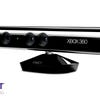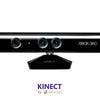Kinect Reviewed
The Eurogamer verdict.
We did all our Kinect testing at home, in the living rooms of our modestly sized urban flats – not at the office. In all cases, getting enough space for two players was a struggle. At Ellie's the solution was to place her TV in the corner of the room and angle it sharply inward. Even then we were awkwardly crammed in between the corner of the sofa and the shoved-aside coffee table, and couldn't quite access the far corners of the playing space.
Put simply, if you ever want to use this thing with two players (and you really should) you need plenty of room. If you don't have the room, don't buy Kinect.
The other principal concern people have about Kinect is lighting and backdrop. This is a completely different story. With the exception of Kinect ID (the feature that recognises you if you step in front of the sensor – more on this later), we found it worked well in a wide range of lighting conditions. That said, like the Wii's sensor bar, it's not too keen on direct sunlight.
Kinect is brilliant at telling players apart from whatever and whoever is behind them, provided they're not inside the playing space. Walk between players and the sensor and it will be confused for a few seconds, but compose itself quickly. Seated play is possible in some games, depending on their design, but it can be a bit glitchy; situating your sofa some 10 feet back from the TV will probably be a bigger problem.
On plugging Kinect in for the first time you're led through a relatively short and painless calibration process called the Kinect Tuner. This process can be repeated if you have difficulties (we never need to do so). Some games require their own calibration, but this is usually minimal. There's something uncanny – in a good way – about the way the motorised head of the device tracks up and down as it checks out your room.
The Tuner also plays a few sounds to get to grips with the room's acoustics, and remarkably this is the only set-up the voice control ever needs; you don't need to teach it your voice or any words. Voice control works superbly for the most part, and the future-cool factor of controlling media playback or selecting menu options with the spoken word far outweighs the faint absurdity of prefacing every command with "Xbox". There's a very slight delay, but it's still better than reaching for the remote or controller.
Kinect ID requires the most set-up. Teaching the device to recognise you involves making your avatar perform a sort of protracted square dance around the playing area, while striking poses. It's funny at first but then a pain, and you need to do this several times over in different lighting conditions before it's reliable.
We never got Kinect ID working flawlessly in every game. However, when it does work it's incredible; stepping into a friend's game, having your profile automatically sign in and then your avatar appear is not just impressively seamless, it's plain magic.
Interface
Knowing Microsoft, it will continue to refine and expand how Kinect works with the Xbox 360 front-end in future updates. We certainly hope so, because the current implementation is disappointingly limited.
You can't use Kinect to control the 360 dashboard as you know it. Not the Xbox Live Marketplace, your friends list, libraries, settings or profile – none of it. Instead, you wave or say "Xbox Kinect" to get the sensor's attention and you're taken to the Kinect Hub. This is a sort of dashboard within a dashboard, a walled garden where you can perform Kinect-approved activities.
You make menu selections by moving your hand to float an on-screen cursor to your desired option. Holding your hand in position for a couple of beats confirms the choice. You'll get used to it, but it's slow, wobbly and frustrating. The 'swipe' gesture system used in Dance Central's menus, and on rare occasions in the main interface, is far superior.
The voice control system works better, but its availability is frustratingly inconsistent and limited. "If you see it, you can say it," boasts the interface – as long as there's a little microphone icon on your screen.
The Kinect Guide, a simple version of the Xbox Guide (for Achievements, signing players in and out and so forth) summoned by holding your left arm out at an angle, doesn't support it. Nor does playback of DVDs or the music on your hard drive.
That's right. If you want to enjoy futuristic voice-controlled media playback (or gesture-controlled, for that matter) and feel like you're in Minority Report (or at least Babylon 5), you're going to have to use Microsoft's faux iTunes - the Zune download and streaming service. This works a treat but your choice of media is limited, as are your payment and ownership options. More to the point, it feels unpleasantly like your hand is being forced.











